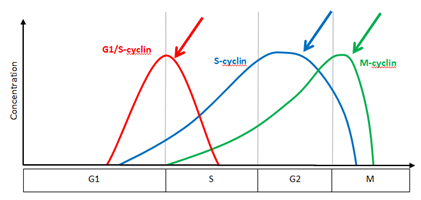Photoperiodism requires
A. increased turgor pressure.
B. a photoreceptor called phytochrome.
C. a biological clock which can measure time.
D. protease inhibitors.
E. a biological clock which can measure time and a photoreceptor called phytochrome only are correct.
Answer: E
You might also like to view...
The following graph represents the concentration of cyclins over the course of the cell cycle. Which of the following statements is TRUE regarding the phase of the cell cycle where the blue arrow is pointing?

A. At this point in the cell cycle, the cell has determined that the DNA is intact, that environmental conditions are favorable, and it is preparing for DNA replication.
B. At this point in the cell cycle, chromosomes have properly aligned on the metaphase plate and are beginning to separate.
C. At this point in the cell cycle, DNA has already been replicated and divided into two daughter nuclei.
D. At this point in the cycle the cell is determining if environmental conditions are favorable for growth and proliferation.
E. At this point in the cycle the cell is continuing to grow and make abundant tubulin proteins.
Which is NOT true about gene mutations?
a. All are transmitted to the next generation. b. They are rare but their rates can be predicted. c. Those with beneficial effects will be favored by natural selection. d. Many reduce an individual's chance of surviving and reproducing. e. Those with neutral effects neither help nor hurt the individual.
Due to changes in their musculature, which vessels can vary the resistance to blood flow?
a. arteries b. veins c. capillaries d. arterioles e. venules.
Which sequence properly describes the flow of blood through a kidney?
A) Renal vein, venule, glomerulus, outgoing arteriole, peritubular capillaries, incoming arteriole, renal artery B) Peritubular capillaries, incoming arteriole, glomerulus, glomerular capsule, outgoing arteriole, renal artery C) Glomerulus, peritubular capillaries, outgoing arteriole, renal artery, incoming arteriole, venule, renal vein D) Renal artery, incoming arteriole, glomerulus, outgoing arteriole, peritubular capillaries, venule, renal vein